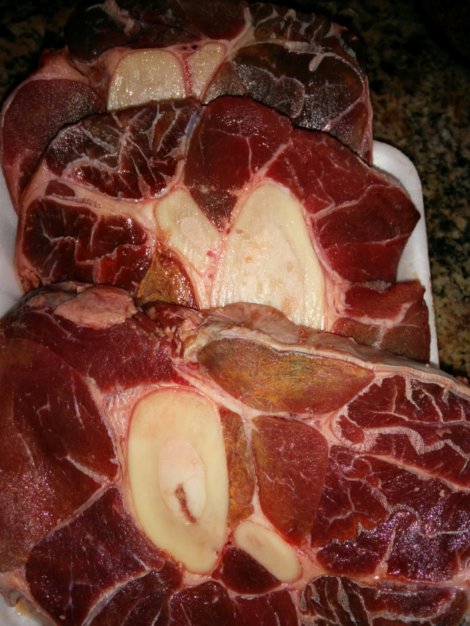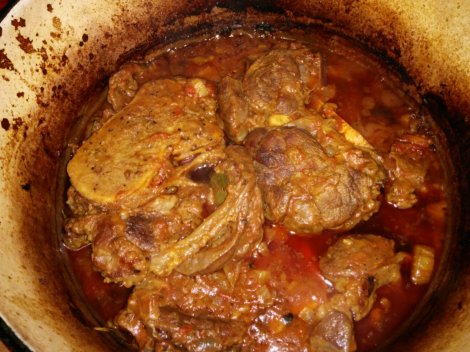Although eating kosher relates primarily to what religious Jews can eat, the rules also govern how we eat them (meat and dairy products can’t be eaten together for example) and, when taken in combination with the rules of the Shabbat (Sabbath) they also govern how we cook.
Shabbat is a day of rest and therefore a whole set of strictures exist regarding what can and cannot be done, including food preparation. In practice what this means is that all cooking has to be carried out before the Shabbat begins (Friday at nightfall) with food either being kept hot or reheated on a hotplate. The post famous example of this is known as “cholent” to Ashkenazic Jews from the Northern European diaspora, or Adafina to Sephardic Jews of the Southern European and North African diasporas – I recommend reading Claudia Roden’s “The Book of Jewish Food” if you’re interested in food origins. Similar to a cassoulet or pot au feu, beans, barley, root vegetables, cheap cuts of meat (for those who could afford it) and other ingredients depending on what was locally available were made into a stew and put into a communal oven on Friday afternoon and taken out after synagogue on Sunday morning.
Nowadays, the main challenge that I face in planning a menu for Shabbat is how to keep my hot menu items from overcooking. In some cases, I’ll simply opt to serve a roast beef at room temperature so that it’s the appropriate level of done-ness (obviously medium-rare). Some dishes lend themselves to being cooked long and low however – one of the reasons why brisket is a mainstay of the Jewish table. Anything that is good braised, can be cooked ahead of time, shouldn’t lose out by being kept warm and may actually be better reheated the day after it cooks.

Osso buco was on sale at the supermarket his week and my wife came home with a package which I received enthusiastically. It turns out that, like most dishes, there are many ways to prepare it (the Guardian does an excellent series on this) and that people are passionate in their opinions. What is agreed upon across the board is that veal shin, sliced across the bone (osso buco means “hole in the bone”) is the correct meat and that it should be braised in stock and white wine, not red. The main disagreement is whether or not to use tomatoes, canned or otherwise. In the event, I found that Gordon’s recipe uses effing tomatoes and if it’s effing good enough for Gordon it’s good enough for me.
I was out of celery but did have some fennel and used that instead and would recommend it. I also decided to follow advice to include some strips of orange zest and added bay leaves and rosemary as that’s what I have on hand out of the suggest herb additions (need to replant my thyme and sage!)
Tradition (which us Jews are very passionate about!) dictates that Osso Buco is served with gremolata – a mixture of finely chopped parsley, lemon zest and garlic to give it some zip. In order to give it an Israeli twist, I substituted mint for the garlic to make limonana gremolata (nana is spearmint in Hebrew and the lemon mint combination is very popular here) – it turned out to be a very successful substitution!
Ingredients
Veal Osso Buco – approximately 1 – 1 1/2 kilos
1 onion roughly diced
2 medium carrots, roughly diced
1 fennel bulb or celery stick or both roughly diced
3 – 4 cloves of chopped garlic
3 strips of orange zest (use a vegetable peeler)
3 – 4 rosemary branches
2 bay leaves
2 glasses of white wine (one for the cooking, one for drinking)
1 cup of stock (can be beef, chicken or as in this case, vegetable as it’s what I had available)
salt and pepper
flour for dusting
oil
For the gremolata
handful of mint leaves
2 garlic cloves
zest of one large lemon
Method
Dust your meat with the flour
Heat oil in a large casserole / dutch oven. Brown your meat in batches (about 5 minutes each side) and remove to a plate.
Preheat your oven to 160c / 325f
In the same pan, add your vegetables and saute gently for about 5 – 6 minutes
Add the garlic, orange zest, rosemary and bay leaves and cook for a further minute.
Return your meat to the pan, add 1 glass or white wine and stock. Bring to the boil and then put on a lid and transfer to the oven for 1 1/2 to 2 hours.
Finely chop the garlic, lemon and mint to make your gremolata.

Your meat should be falling of the bone and the marrow should be soft and melted away.
Serve over polenta, mashed potato, rice of couscous (I went for mashed potato). Yum!

Next day leftovers were possibly even better!



So interesting to read about different cultures and traditions 🙂
I do find your posts incredibly interesting – now that you mention why brisket is found throughout Jewish cooking, of course it makes sense!! I love Osso Bucco. The version I make is not dissimilar to yours and comes from the grand doyenne of Italian cookery, Marcella Hazan. I tend to make mine in a large roasting dish so that the shanks stay flat and the bone marrow stays put. And I always serve a risotto milanese with them -creamy saffron rice and a rich tomatoey sauce are heaven on a plate. I totally understand that you couldn’t cook risotto for the Shabbat though…
Brisket gained popularity by being cheap! Cooking method is a happy coincidence! Risotto Milanese is the traditional accompaniment. Will have to make a non dairy version mid week sometime!